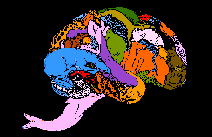
Mammalian Anatomy Lab

1. Students should know the internal and external structures of both sexes. That means looking at a pig of the opposite sex from your own pig !

2. The easiest way to dissect the pig is to follow the directions in order in the lab manual. That way parts won't be removed that need to be seen later. If done properly, students should be able to see every structure in the same pig ! If deeper structures need to be seen, then the more superficial structures should be left intact on the contralateral side.

3.
Students are responsible for the following :All the boldface terms, plus any additional terms shown in figures 26.1, 2, 3, 4, 5, 6, 9
For figures 26.7, 26.8, 26.10, 26.11, 27.14 students do not need to know any blood vessels that are not described in the text.
Students do not need to know spermatic and ovarian veins or arteries.
Male and female reproductive structures (27.5 and 27.8) can be seen on models in lab.
Parts of the kidney (fig. 27.2) also can be seen on models and preserved sheep kidneys.
Parts of the heart can be seen on preserved sheep hearts and on the model of a human heart.
Boldface terms on pages 26-3a, 26-4a for the human skeleton.
Fig 26.12 should be used to understand the models of the human torsos; students are responsible for knowing all of those structures and their general functions of both male and female torsos.
Understand the unique features of the fetal circulation and how they differ from the circulation in the adult mammal. : (foramen ovale = opening between rt & left atria, ductus arteriosis = short vessel between pulmonary trunk and aorta, umbilical arteries = take blood from iliac arteries to placenta, umbilical vein = returns blood from placenta to liver; found in umbilical cord, ductus venosus = continuation of umbilical vein that takes blood to posterior vena cava; passes through liver). Fetal structures/ openings are shown on p. 27-3a. Adult circulation is shown on p. 27-4a.

4. For dissection of the heart and other internal organs, students should work in groups of 4, so the pig from one of the pairs of students (the best dissected?!) can be left intact to observe the surrounding structures.

5. Be sure to look at preserved sheep brain, pig uterus, pig lungs, etc. You do not need to know any specific parts of these organs, but you should be able to recognize which organs they are.

6. Students should look at slides of testes (fig. 27.9) and ovaries (fig. 27.10). Remember that gametogenesis (fig. 8.11) involves the process of meiosis (fig. 8.12).
 click here to return to Cell 211 homepage
click here to return to Cell 211 homepage